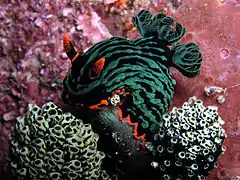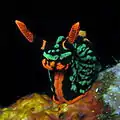Nembrotha kubaryana
Nembrotha kubaryana, also known as the variable neon slug or the dusky nembrotha, is a species of colorful sea slug, a dorid nudibranch, a marine gastropod mollusk in the family Polyceridae.[3]
| Nembrotha kubaryana | |
|---|---|
 | |
| Feeding on tunicates | |
| Scientific classification | |
| Kingdom: | |
| Phylum: | |
| Class: | |
| (unranked): | clade Heterobranchia clade Euthyneura clade Nudipleura clade Nudibranchia clade Euctenidiacea clade Doridacea |
| Superfamily: | |
| Family: | |
| Subfamily: | |
| Genus: | |
| Species: | N. kubaryana |
| Binomial name | |
| Nembrotha kubaryana Bergh, 1877 | |
| Synonyms[1][2] | |
|
| |
Synonymy
Its synonyms include Nembrotha nigerrima.[1][2]
The two names Nembrotha nigerrima and N. kubaryana were published simultaneously by Rudolph Bergh in 1877, the first one on page 451, the second on page 454. Yonow & Hayward (1991) treated the two names as synonyms and, acting as first revisers, gave precedence to kubaryana over nigerrima. Pola et al. (2008) agreed with the synonymy, but initially rejected Yonow & Hayward's nomenclatural act, arguing that nigerrima had page precedence over kubaryana. However, the ICZN Code does not contain such a thing as "page precedence", and Yonow & Hayward's (1991) action was valid – and this position has been repeated by Yonow (2011).[3] Pola et al. reversed their conclusion and accepted Yonow's act as first reviser in a following paper later the same year.[2]
Distribution
This species occurs in the tropical Western Indo-Pacific.[4]
Description
This animal can reach a total length of more than 120 mm. It is a large dark-bodied nudibranch which may have green stripes running down the length of the body or have green raised spots. The margin of the foot and head is a vivid red-orange. The rhinophores and gills may be red or green. Nembrotha kubaryana is easily confused with a similar species, Nembrotha cristata although the latter has no red orange border on its foot.
Ecology
The variable neon slug feeds on ascidians and has been observed feeding on the green-ringed ascidian, Sigillina signifera.[4]
.jpg.webp) Nembrotha kubaryana at Verde Island, the Philippines.
Nembrotha kubaryana at Verde Island, the Philippines. N. kubaryana eating Oxycorynia fascicularis tunicates
N. kubaryana eating Oxycorynia fascicularis tunicates N. kubaryana
N. kubaryana.jpg.webp) N. kubaryana in East Timor
N. kubaryana in East Timor N. kubaryana from Bali
N. kubaryana from Bali
Chemical defences
N. kubaryana uses the toxins in its prey ascidians to defend itself against predators.[5] It stores the ascidian's toxins in its tissues and then releases them in a slimy defensive mucus when alarmed.
References
- Pola M., Cervera J. L. & Gosliner T. M. (2008) "Revision of the Indo-Pacific genus Nembrotha (Nudibranchia: Dorididae: Polyceridae), with description of two new species". Scientia Marina 72(1): 145-183. doi:10.3989/scimar.2008.72n1145
- Pola M., Cervera J. L. & Gosliner T. M. (2008) "Description of the First Roboastra Species (Nudibranchia, Polyceridae, Nembrothinae) from the Western Atlantic". Bulletin of Marine Science 83(2): 391-399.
- Bouchet, P. (2014). Nembrotha kubaryana Bergh, 1877. Accessed through: World Register of Marine Species at http://www.marinespecies.org/aphia.php?p=taxdetails&id=527322 on 2014-12-21
- Seaslugforum.net
- Paul, V. J., Lindquist, N., Fenical, W., Chemical defenses of the tropical ascidian Atapozoa sp. and its nudibranch predators Nembrotha spp., MEPS 59:109-118 (1990)
Further reading
- Debelius, H. 2001. Asia Pacific Reef Guide ISBN 3-925919-56-2
- Yonow N. (2011) Results of the Rumphius Biohistorical Expedition to Ambon (1990). Part 15. The suborder Doridina (Mollusca, Gastropoda, Opisthobranchia, Nudibranchia). Zoologische Mededelingen 85(17): 905-956
External links
| Wikimedia Commons has media related to Nembrotha kubaryana. |
| Wikispecies has information related to Nembrotha kubaryana. |
- Nembrotha kubaryana page at nudipixel
- Photos of Nembrotha kubaryana on Sealife Collection